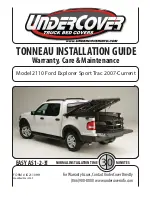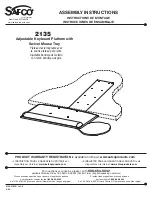
Operators Guide
12
Stability
Use the mid-level or floor spreader to ensure that the tripod legs are spread sufficiently, so that
the C of G of the tilted payload remains within the footprint of the tripod.
Balancing the head
Make sure that the head is level before balancing. Check the bubble level to verify that the head
itself is level and make sure that the platform is also level.
Balancing the 1030 head achieves two objectives: First, when a head is correctly balanced, the
operator will only need a minimum amount of effort to move the camera. Second, once balanced,
the head and its payload can be set to any tilt position and the head will maintain this position
with ‘hands off’.
The chart below shows the range of load and C of G heights that can be maintained in balance.
The area below the balance curve (to the left) corresponds to load/C of G combinations that can
be balanced over the full tilt range of ±90° for the 1030D (Figure 3) and ±60° for the 1030Ds head
(Figure 4), respectively. The area above the balance curve (to the right) corresponds to load/
C of G combinations that exceed the capacity of the head.
WARNING!
When mounting the head on a tripod, it is possible to set the tripod legs so
that the C of G of the tilted payload falls outside the footprint of the tripod,
leading to instability.
NOTE: It is important that the handle(s) and all camera accessories (lens, zoom and
focus controls, viewfinder, etc.) are fitted in their operational position before
balancing the head. Any equipment fitted or adjusted later can unbalance the
head requiring the camera setup to be rebalanced.
Figure 3 Counterbalance chart – 1030D
1030D COUNTERBALANCE CHART
10 20 30 40 50 60 70 80 90 100110120130140150
4.5 9 14 18 23 27 32 36 41 45 50 54 60 64 68
12
10
8
6
4
2 51
102
152
203
254
305
0
CAMERA
CENTER OF GRA
VITY
ABOVE PLA
TFORM
CAMERA WEIGHT
in mm
lbs
kg
14
16
18
356
406
457
Summary of Contents for 1030D
Page 2: ......
Page 3: ...OConnor 1030D 1030Ds Fluid Head Operators Guide Publication Part No C1239 4980 Issue 1 ...
Page 21: ......








































